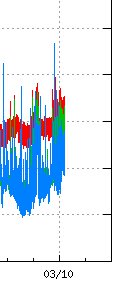Earlier tonight a second harmonic pulse was seen on Grímsvötn SIL station. This time the harmonic pulse has lasted longer and is still ongoing when this is written. What is creating this harmonic pulse is unclear at this moment. But at current time Grímsvötn lake is full of water. It might well be that the water is on the move and is leaving the Grímsvötn lake. However it is not going to be clear if that is the case or not in the next few hours. I would not be surprised if it goes both ways. That is the water is on the move and that it might not be on the move at all.

The second harmonic tremor seen on SIL station run by the IMO. Picture credit, Icelandic Met Office.
Grímsvötn SIL station. Click here for the full list of SIL station run by Icelandic Met Office.

The harmonic pulse just took a new jump just now (10 min average shown on IMO tremor plots).
@Jón: I know, it’s a bit late for comments, but I’m expecting something coming from Vatnajökull, although EQ activity has moved again to Herðubreiðartögl. I don’t know what does it mean, but swarms usually follow a pattern, starting there and coming down towards Grimsvötn. And if the water lake is on the move, it could be as well getting reach of hot material underneath. So, there are not many choices here, in my understanding.
Nah, it’s over on the right hand side under the Meta Heading.
I still haven’t gotten my confirmation mail, and I’m tired of pondering an odd 27.96 day and 41.94 day peak in the FFT for the summed Icelandic quakes. It’s got to be late if I have resorted to stuff that odd.
N/M… wrong thread.
Jón, take a look at station Krokottuvotn! There are at least 11 pulses similar to the ones you report for Grímsvötn. The IMO says it’s in the Mývatn area (close to Krafla?), but where is it and which volcanic system might be responsible IF it’s harmonics?
@Henrik: If it is in the Mývatan area, hydrothermal flows could be easily blamed. Many geysers there.
A thought – how long before Icelandic scientists such as Magnús Tumi Guðmundsson or Páll Einarsson take note of this blog and warn others about reading too much into our speculations? 😉
@MOTSFO – a while ago you were asking about some of the jökullhlaup screen captures – try this for time lapse videos from ‘astrograph’.
@Renato Rio, Earthquake swarms do not have to follow a pattern. But sometimes they do.
@Henrik, This might be a question of increased hydrothermal activity at Grímsvötn ? I am not sure what is going on.
Looking at Hvolvölur cam, I’m not so sure about the cloud formation hovering above Eyjaf’s crater…
They look like MGSC-clouds to me, Renato.
@Henrik: I don’t know what MGSC means (MG strato cumuli?) but it is beautiful anyway. It’s just so peaceful to gaze at clouds, one can’t imagine how it looked just five months ago…
Try “Mountain Grazing”! 😉
@Henrik: OK. You got an angry face this time. >:(
LOL
Renato Rio, I don’t see any angry face. Maybe you are seeing different faces here.
@Jón: That was supposed to be a joke: nobody’s angry here and the sun is shining below. 🙂
@ Renato and Jón: Which angry faces??? I also see none! 😉
@Strahlende Diana: Your name was supposed to mean the Moon Goddess , and instead, you grant us with the sun. Thank you. I think the only ones who are angry around here are the Icelandic volcanoes, but looks like they too are taking a “sunday break”.
@not angry Renato: Here the picture from the hawaiian sun:
http://www.flickr.com/photos/54065356@N02/5045528437/in/set-72157624864462359/
May be this energy helps to calm the volcanoes in Iceland and extend the “sunday break”. 🙂
@Diana: Diana, thanks for the pic. You deserved a bigger avatar to show its beauty in full scale. 🙂
Great blog yours!
It’s quite natural that Grimsvotn erupts again this winter; after all it has been erupting recently every 5-6 years. In fact it’s interesting that the earthquake swarms in Vatnajökull are however focused in 2 other locations: southwest along the Bardarbunga fissuse and to the northeast of Askja. Both these regions also showed GPS changes in recent months. SW of Bardarbunda, actually quite close to Grimsvotn, is Loki-Fögrufjöll volcano: I feel this one will be the next eruption in Iceland.
And with the increased earthquake activity in the western rim of Myrdalsjökull, Katla is another likely candidate for an eruption in the near future.
In your assesment for Katla, are you factoring in the usual seasonal summer quake activity related to glacial shrinking/shifting and if so, is this summer unusual in its qualities such as depth, frequency, location, clustering, etc. These are some of the questions I have been searching for answers to – i.e., is this summer more indicative of increased magma presence.